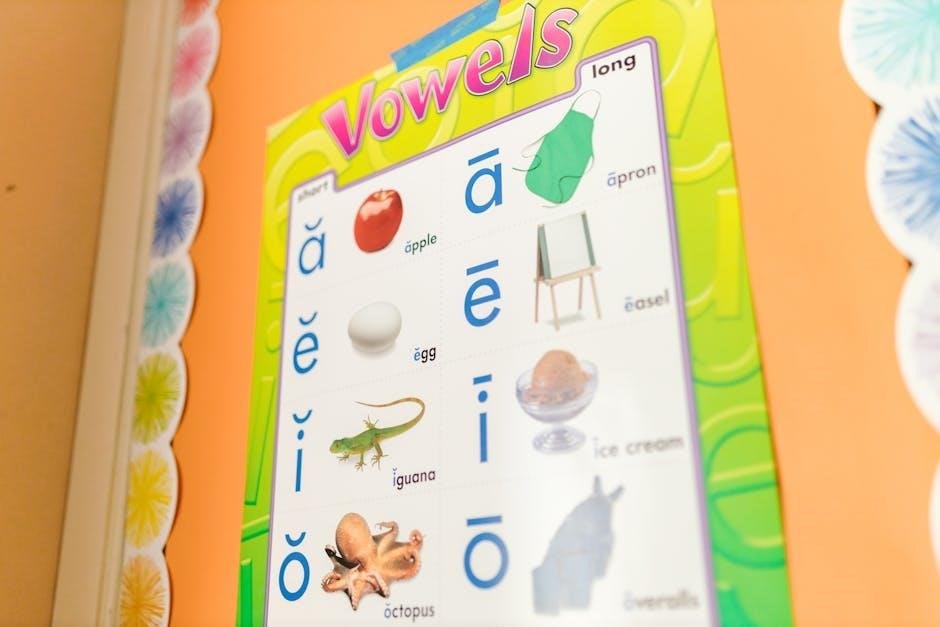A rod guide size chart is essential for selecting the right guides, ensuring optimal performance for spinning, casting, or fly fishing. It provides detailed measurements and specifications to match your fishing needs, helping you avoid common mistakes and tailor your gear for specific species and conditions. This guide offers clear charts and steps for measuring and installing rod guides, covering various manufacturers like TiForged, MicroWaves, Virtus, and Artus; Whether you’re targeting small trout or large saltwater species, this resource helps you make informed decisions for the best fishing outcomes.

1.1 What Are Rod Guides?
Rod guides are circular or looped components attached along a fishing rod’s length, designed to manage and direct the fishing line. Typically made from materials like ceramic, stainless steel, or titanium, they play a crucial role in line control and casting performance. Guides vary in size, with larger ones near the reel and smaller ones toward the tip, ensuring even line distribution. Their primary function is to reduce line friction, prevent tangling, and enhance casting accuracy. Properly sized guides improve sensitivity, allowing anglers to detect bites more effectively. Different materials offer varying levels of durability and resistance to corrosion, making them suitable for freshwater or saltwater environments. Understanding rod guides is fundamental for optimizing fishing gear and achieving better results on the water.
1.2 Importance of Rod Guides in Fishing
Rod guides play a crucial role in fishing, as they directly impact line control, casting accuracy, and overall fishing performance. They reduce line friction, preventing wear and tear, and ensure smooth line flow during casts and retrieves. Properly sized guides enhance sensitivity, allowing anglers to detect even subtle bites. They also distribute stress evenly along the rod, reducing the risk of line breakage during fights with larger species. Guides are essential for maintaining balance and responsiveness in the rod, making them a critical component for both freshwater and saltwater fishing. Their importance lies in their ability to optimize casting distance, accuracy, and durability, ensuring a more effective and enjoyable fishing experience.
1.3 Purpose of a Rod Guide Size Chart
The purpose of a rod guide size chart is to help anglers select the optimal guide size for their fishing needs, ensuring compatibility with specific rod types and conditions. These charts provide detailed measurements, including ring I.D., foot lengths, and heights, to match guide diameters with target species and fishing environments. By referencing these charts, anglers can avoid common mistakes, such as using guides that are too large or small, which can affect casting performance and durability. The chart also helps in tailoring gear for specific applications, whether freshwater, saltwater, or ice fishing, ensuring the best possible outcome. This resource is invaluable for both novice and experienced anglers seeking to enhance their fishing experience.

Understanding Rod Guide Sizes
Rod guide sizes vary based on material and fishing type, affecting performance. Understanding these factors helps anglers choose the right guides for their specific needs, optimizing gear effectiveness.
2.1 Factors Influencing Rod Guide Size
The size of rod guides is influenced by several key factors, including the type of fishing, target species, and rod length. For freshwater fishing, smaller guides are often sufficient, while saltwater fishing requires larger, more durable guides to handle heavier lines and larger species. The rod’s action and length also play a role, with longer rods typically needing more guides to distribute stress evenly. Additionally, the line weight and type of fishing technique, such as spinning, casting, or fly fishing, impact guide size. Materials like titanium or ceramic further affect durability and performance. Ensuring the right guide size enhances casting accuracy, reduces line wear, and improves overall fishing efficiency. Proper guide selection is crucial for a balanced and effective fishing setup.
2.2 Common Rod Guide Materials and Their Sizes
Rod guides are made from various materials, each offering unique benefits. Stainless steel guides are durable and resistant to corrosion, commonly sized between 6 to 20. Ceramic guides are lightweight and reduce line friction, typically ranging from 4 to 12. Silicon carbide guides are hard and wear-resistant, often used in saltwater fishing, with sizes varying from 5 to 15. Titanium guides are strong and corrosion-resistant, ideal for heavy-duty fishing, usually sized between 8 to 18. The size of the guide ring (I.D.) is crucial, as it affects line flow and performance. Smaller guides are better for lightweight fishing, while larger ones are suited for heavy lines and larger species. Proper material and size selection ensure optimal rod balance and fishing efficiency.
2.3 How to Measure Rod Guide Size
Measuring rod guide size accurately is crucial for optimal performance. Start by using a digital caliper to measure the inner diameter (I.D.) of the guide ring, ensuring it matches your line size. Next, measure the overall length of the guide, including the foot, to ensure compatibility with your rod blank. For accuracy, align the caliper with the guide’s base and measure from the tip to the butt. Refer to manufacturer size charts for specific models, as sizes vary by brand and type. Proper measurement ensures the guide fits securely, preventing issues like line tangles or weak spots. Always double-check measurements against recommended specifications for your fishing application to achieve the best results.

Rod Guide Size Chart Breakdown
This section provides detailed size charts for spinning, casting, and fly rods, helping anglers choose the right guide sizes based on fishing conditions and target species.

3.1 Spinning Rod Guide Size Chart
A spinning rod guide size chart provides specific measurements for selecting the ideal guides based on rod length and fishing application. These charts typically outline ring diameters, spacing, and foot lengths, ensuring optimal performance for spinning setups. For freshwater fishing, smaller guides (e.g., 4-8 mm) are often recommended, while saltwater spinning rods may require larger sizes (8-12 mm) to handle heavier lines and larger species. The chart also considers the rod’s action and target species, helping anglers avoid common mistakes like using oversized or undersized guides. By referencing these charts, anglers can ensure proper line flow, reduced friction, and improved casting accuracy, ultimately enhancing their fishing experience.
3.2 Casting Rod Guide Size Chart
A casting rod guide size chart provides specific measurements for selecting the ideal guides, ensuring optimal performance for various casting techniques. These charts detail guide diameters, spacing, and placement, tailored to different rod lengths and fishing applications. For casting rods, guide sizes typically range from 6 to 20, with larger diameters suited for heavier lines and larger species. The chart helps anglers match guide sizes to their fishing needs, whether targeting bass, walleye, or other species. Proper guide sizing enhances casting accuracy, line control, and overall rod sensitivity. By referencing the chart, anglers can avoid common mistakes, such as using guides that are too small or too large for their setup. This ensures a balanced and efficient fishing experience.
3.3 Fly Rod Guide Size Chart
A fly rod guide size chart is tailored for the unique demands of fly fishing, focusing on lighter lines and precise casting. These charts specify smaller guide diameters, typically ranging from 1mm to 4mm, to accommodate thin fly lines and leaders. The guides are spaced to ensure smooth line flow and minimal friction, crucial for long casts. Materials like titanium or ceramic are common due to their lightweight and durability. The chart often includes measurements for guide height, ring I.D., and foot length, ensuring compatibility with various fly rod blanks. Proper sizing enhances casting accuracy and reduces line tangling. By referencing the chart, anglers can select guides that match their specific fly fishing needs, whether targeting trout in freshwater or larger species in saltwater.
Guide Spacing and Its Importance
Proper guide spacing is crucial for optimal rod performance, ensuring balance and casting accuracy. It can be tailored to specific fishing needs for the best results.
4.1 Guide Spacing Chart for Different Rod Lengths
Guide spacing varies based on rod length, with measurements taken from the tip to the butt. For shorter rods (5-6 feet), guides are closer together, typically spaced 1-2 inches apart, improving control and sensitivity. Medium-length rods (6-7 feet) often use 2-3 inch spacing, balancing casting distance and accuracy. Longer rods (7-9 feet) may have guides spaced 3-4 inches apart, optimizing line flow and distance. These spacings can be adjusted to suit specific fishing styles or target species. Proper spacing ensures even line distribution, reducing friction and improving casting performance. Manufacturers provide recommended charts, but anglers can fine-tune spacing based on personal preference or fishing conditions.
4.2 Factors Affecting Guide Spacing
Guide spacing is influenced by several factors, including rod length, type, and action. Longer rods require more guides and wider spacing, while shorter rods need fewer guides and tighter spacing. The target species and fishing technique also play a role, as larger species demand stronger, more durable setups. Line weight and lure size further impact spacing, with heavier lines requiring guides spaced to handle increased stress. Additionally, the material and flexibility of the rod blank affect how guides are positioned to optimize performance. Manufacturer recommendations and personal preference also shape guide spacing, ensuring compatibility with specific fishing conditions and styles. Proper spacing enhances casting accuracy, reduces line wear, and improves overall fishing efficiency.
4.3 How to Adjust Guide Spacing for Specific Fishing Needs
Adjusting guide spacing on your fishing rod is crucial for optimizing performance based on your fishing style and target species. Start by referencing a standard guide spacing chart for your rod length and type, then fine-tune the placement. For longer rods, increase spacing near the tip for better cast control. Shorter rods may require tighter spacing for precision. Consider the species you’re targeting; larger fish demand stronger, more evenly spaced guides. Experiment with spacing to achieve the perfect balance between sensitivity and durability. Test your setup by casting and retrieving to ensure smooth line flow. Adjustments may vary, so keep a record of what works best for your specific fishing conditions.
Selecting the Right Rod Guide Size
Match guide size to fishing conditions and target species for optimal performance. Manufacturers provide charts to ensure compatibility, helping anglers avoid mistakes and tailor gear effectively.
5.1 Matching Guide Size to Fishing Conditions
Matching guide size to fishing conditions ensures optimal performance and durability. For freshwater fishing, smaller guides are often sufficient, while saltwater fishing requires larger, more robust guides to handle heavier lines and larger species. The type of fishing, such as spinning, casting, or fly fishing, also influences guide size selection. In fast-moving waters or deep-sea conditions, larger guides help manage line stress and prevent damage. Conversely, smaller guides are better for precision and sensitivity in calm or shallow waters. Consulting a rod guide size chart helps anglers choose the right size based on their specific fishing environment and target species, ensuring the gear is tailored for the best possible outcome. Proper guide sizing enhances casting accuracy, line control, and overall fishing efficiency.
5.2 Choosing Guide Size Based on Target Species
Choosing the right guide size based on your target species is crucial for optimal fishing performance. Larger species, such as tuna or marlin, require heavier guides to withstand the stress of fighting powerful fish. Conversely, smaller species like trout or panfish need lighter guides to maintain sensitivity and avoid overwhelming the fish. The guide size should match the strength and size of the target species, ensuring the rod’s balance and durability. For example, saltwater fishing for large species may require guides with larger ring diameters to accommodate thicker lines, while freshwater fishing for smaller species often uses smaller, more precise guides. Proper guide selection enhances casting accuracy, reduces line wear, and improves overall fishing effectiveness. Always consult size charts to ensure compatibility with your target species and fishing conditions.
5.3 Avoiding Common Mistakes in Guide Size Selection
When selecting rod guide sizes, anglers often overlook critical factors, leading to suboptimal performance. A common mistake is ignoring the size chart altogether, assuming one size fits all. This can result in poor line control, reduced casting accuracy, and increased wear on the rod. Another error is not considering the target species or fishing conditions, such as freshwater vs. saltwater, which require different guide diameters. Using guides that are too small or too large can compromise sensitivity and durability. To avoid these pitfalls, always consult a rod guide size chart and match the specifications to your specific fishing needs. Proper guide selection ensures better casting, increased sensitivity, and a more enjoyable fishing experience. Manufacturers provide detailed charts to help anglers make informed decisions, so use these resources to avoid costly mistakes.

Manufacturer-Specific Rod Guide Charts
Manufacturer-specific charts provide detailed guide specifications for models like TiForged, MicroWaves, Virtus, and Artus, ensuring compatibility with specific rod types and fishing conditions.
6.1 TiForged Guide Size Specifications
TiForged rod guides are known for their durability and performance, offering precise size specifications to meet various fishing demands. Their size charts include detailed measurements such as ring I.D., foot length, and height, ensuring compatibility with different rod types. These specifications are tailored to match fishing conditions, whether for freshwater or saltwater applications. TiForged guides are designed to handle both small trout and large species, providing anglers with a reliable choice. The charts also address factors like weight distribution and guide spacing, helping anglers avoid common mistakes. By referencing TiForged’s official guide specifications, anglers can select the optimal guides for their rods, ensuring enhanced casting accuracy and overall fishing performance. These resources are invaluable for custom rod builders and enthusiasts alike.
6.2 MicroWaves Guide Size Specifications
MicroWaves guide size specifications are designed to optimize performance for various fishing applications. These guides are known for their durability and weight reduction, making them ideal for both freshwater and saltwater fishing. The size chart includes detailed measurements such as ring I.D., foot length, and height, ensuring compatibility with different rod types. MicroWaves guides are popular among anglers due to their strength and sensitivity, allowing for precise casting and line control. The specifications cater to a wide range of fishing needs, from lightweight trout fishing to heavy-duty saltwater angling. By referencing the MicroWaves guide size chart, anglers can select the perfect guides to enhance their fishing experience and achieve better results on the water.
6.3 Virtus and Artus Guide Size Specifications
Virtus and Artus guide size specifications are designed to meet the demands of various fishing applications, offering precise measurements for optimal performance. These charts provide detailed information on ring I.D., foot length, and height, ensuring compatibility with different rod types and fishing conditions. Whether targeting freshwater or saltwater species, Virtus and Artus guides are tailored to deliver durability and sensitivity. The specifications cater to both small trout and large saltwater fish, allowing anglers to select guides that match their specific needs. By referencing these charts, anglers can avoid common mistakes and ensure their gear is well-suited for the intended use. This resource is part of the manufacturer’s commitment to providing anglers with tools to enhance their fishing experience.

Rod Guide Size Chart for Different Fishing Applications
A rod guide size chart tailors selections for freshwater, saltwater, and ice fishing, ensuring optimal performance across diverse fishing applications and species, with specifications from top manufacturers.
7.1 Freshwater Fishing Rod Guide Sizes
Freshwater fishing rod guide sizes vary based on the type of fishing and target species. For lighter applications, such as panfish or trout, smaller guide sizes (4-8) are ideal, ensuring sensitivity and precision. Medium-sized guides (8-12) are suitable for bass or walleye, balancing durability and performance. Larger guides (12-16) are recommended for heavier freshwater species like pike or muskie, providing strength and line control. The size chart helps anglers match guide diameters to their specific needs, ensuring optimal casting distance and accuracy. Proper guide sizing also prevents line tangles and wear, enhancing the overall fishing experience. Always consult manufacturer specifications for detailed size recommendations tailored to your freshwater fishing setup.
7.2 Saltwater Fishing Rod Guide Sizes
Saltwater fishing requires durable and appropriately sized rod guides to handle the stress of larger species and harsh marine conditions. Guide sizes for saltwater rods typically range from 10 to 20, with larger diameters for heavy-duty applications. For example, a 15-20 size guide is ideal for offshore fishing, while smaller sizes (10-12) are better for lighter inshore or flats fishing. Materials like stainless steel or ceramic are preferred for their corrosion resistance. The size chart helps match guide diameters to specific fishing needs, ensuring compatibility with line weight and species size. Proper guide sizing enhances casting distance, reduces line wear, and improves overall rod performance in saltwater environments. Always refer to manufacturer specifications for optimal results.
7.3 Ice Fishing Rod Guide Sizes
Ice fishing rods typically require smaller guide sizes due to their shorter length and the need for sensitivity. Guides for ice fishing rods usually range from 4 to 6 inches in spacing, with smaller diameters to accommodate lighter lines and icy conditions. The smaller size ensures better line control and minimizes ice buildup, which can interfere with casting and retrieval. Materials like stainless steel or ceramic are preferred for durability in cold environments. Proper guide sizing is crucial for detecting subtle bites and managing the lightweight lures commonly used in ice fishing. By selecting the right guide size, anglers can enhance their ice fishing experience, ensuring better performance and reliability in freezing conditions.

Tools and Resources for Rod Guide Measurement

Essential tools include calipers and measuring tapes for accurate guide sizing. Online resources like manufacturer websites and downloadable charts provide detailed specifications. Software tools aid custom spacing.
8.1 Essential Tools for Measuring Rod Guides
To accurately measure rod guides, you’ll need a few essential tools. A digital caliper is ideal for precise measurements of guide inner diameters and heights. A ruler or measuring tape can help determine guide spacing along the rod blank. A marker is useful for marking guide positions before installation. Additionally, a small scale or balance can measure the weight of guides to ensure compatibility with your rod’s intended use. For more precise measurements, a micrometer can be used to measure the guide’s inner diameter and foot length. These tools ensure accuracy and help you select the right guides for your fishing setup, whether you’re building a custom rod or upgrading an existing one.
8.2 Online Resources for Rod Guide Size Charts
Online resources provide convenient access to detailed rod guide size charts, ensuring anglers can make informed decisions. Many manufacturers, such as TiForged, MicroWaves, Virtus, and Artus, offer official guide specifications on their websites. These charts include measurements like ring I.D., foot lengths, and weight, tailored to specific fishing needs. Additionally, websites often provide guide spacing recommendations for various rod lengths and types, which can be adjusted to suit individual preferences. Links to these resources are typically found on the home pages of manufacturer websites, making it easy to access the information. By utilizing these online tools, anglers can avoid common mistakes and ensure their gear is optimized for the best fishing outcomes.
8.3 Software for Custom Rod Guide Spacing
Software for custom rod guide spacing offers anglers precise tools to design and optimize their rod setups. These programs allow users to input specific rod lengths, guide sizes, and fishing conditions to generate ideal spacing configurations. Many manufacturers provide digital tools that align with their guide specifications, ensuring compatibility and performance. For example, software might calculate the optimal distance between guides based on the rod’s action, target species, and line type. Some programs also offer visual representations, enabling anglers to preview and adjust their guide placement before installation. This technology enhances accuracy, improves casting performance, and ensures durability, making it a valuable resource for both novice and experienced rod builders seeking tailored solutions.
Step-by-Step Guide to Installing Rod Guides

Prepare the rod blank, align guides evenly, attach securely using epoxy or thread wraps, and test for proper alignment and functionality to ensure optimal performance.
9.1 Preparing the Rod Blank
Preparing the rod blank is the first step in installing rod guides. Start by cleaning the blank to remove any dirt, oil, or residue, ensuring a smooth surface for guide attachment. Inspect the blank for any damage or imperfections that could affect guide placement. If necessary, lightly sand the area where guides will be mounted to create a better bond. Align the blank on a flat surface or use a rod-building jig to maintain straightness. Measure and mark the guide positions according to your spacing chart, starting from the tip and moving toward the butt. Double-check all measurements to ensure accuracy before proceeding. Proper preparation ensures a professional-grade setup and optimal performance for your fishing rod.
9.2 Aligning and Attaching the Guides
Aligning and attaching guides requires precision to ensure proper rod performance. Start by positioning the guides according to the spacing chart, ensuring even distribution. Lightly sand the rod blank where the guides will be attached to create a clean surface. Apply a small amount of adhesive, such as epoxy, to the guide foot and press it firmly onto the blank. Use a guide wrapping tool to secure the guide in place, wrapping thread tightly around the foot. Repeat for each guide, referencing the spacing chart to maintain accuracy. Once all guides are attached, allow the adhesive to cure fully before testing the rod. Proper alignment and secure attachment are critical for optimal casting and durability.
9.3 Testing the Guide Setup
After installing the rod guides, it’s crucial to test the setup to ensure optimal performance. Start by checking the alignment of all guides, as misalignment can cause line issues. Next, test the flexibility of the rod by gently bending it to see if the guides rotate smoothly without binding. Check the line flow through each guide to ensure it moves freely without tangling or catching. Finally, perform a drag test by attaching a weight or lure to simulate fishing conditions, ensuring the guides withstand stress without damage. Proper testing ensures your rod is balanced, responsive, and ready for various fishing scenarios, enhancing your overall angling experience.
